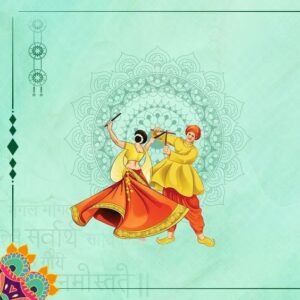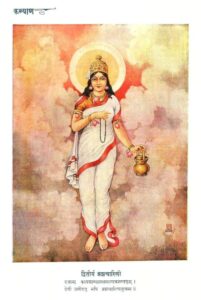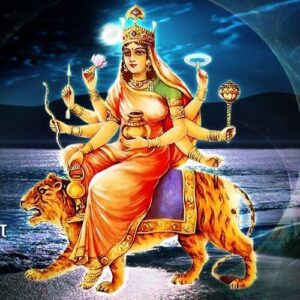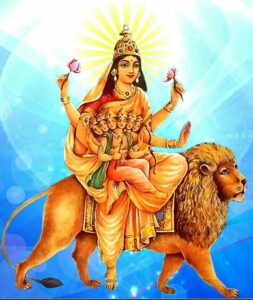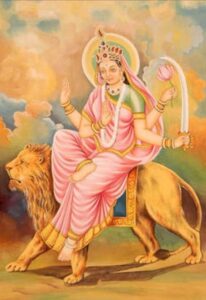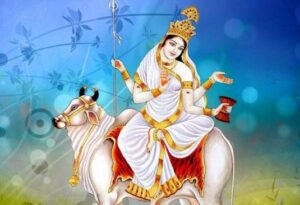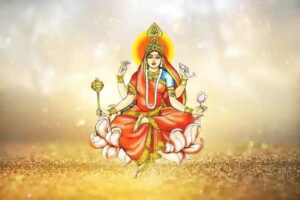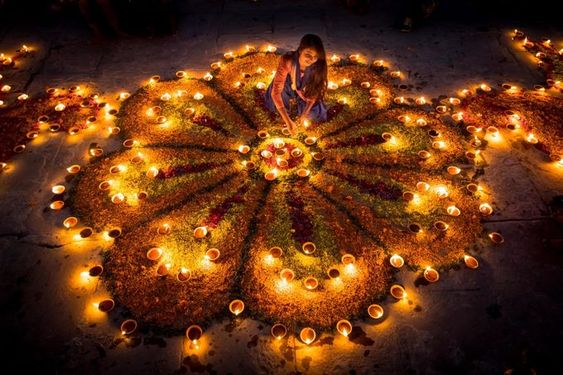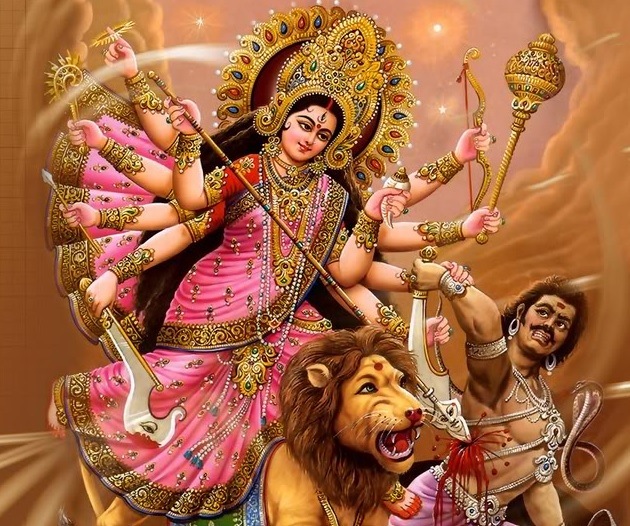Navratri: A Celebration of Divine Femininity
Navratri means “Nine Nights” in Sanskrit. around the course of nine days and nights, people all around India celebrate this colourful and culturally significant holiday. Traditional rituals, deep mysticism, and heartfelt devotion characterise this celebration of the Divine Mother, Goddess Durga. Navratri is a time of prayer, fasting, and lively dances like Garba and Dandiya Raas to celebrate the triumph of good over evil. As a symbol of reverence for the sacred feminine, it strengthens women. Navratri is a nine-day festival celebrated across India in ways that are both traditional and innovative.
Significance of Navratri
The nine-day and nightlong Navratri event has great significance in Hinduism and Indian culture. At its heart, it celebrates the triumph of good over evil, symbolised by the victory of Goddess Durga over the monster Mahishasura. However, Navratri is much more than a story of bravery; it is a quest for enlightenment. Fasting, prayer, and meditation are common practices among believers as they seek spiritual renewal through these means. Goddess Durga is the embodiment of the pure feminine energy that is celebrated throughout this festival.
It promotes cultural harmony by breaking down barriers of race, class, and gender through the shared experience of dynamic dances like Garba and Dandiya Raas. In addition, fasting and rituals are practised during Navratri to purify the body and revive the soul. Navratri is an essential component of India’s cultural tapestry since it is a multifaceted festival honouring spirituality, culture, and the victory of good.
Historical Roots of Navratri
The Hindu holiday of Navratri, celebrated over nine nights, has centuries-long historical origins in India’s rich culture. The Puranas and other ancient Hindu texts detail how it is connected to Hindu mythology. Navratri is a nine-day festival honouring Goddess Durga in her many incarnations as the sacred feminine spirit. The narrative of Goddess Durga’s victory over the buffalo monster Mahishasura symbolises the triumph of good over evil and is celebrated during this festival. Throughout the Indian subcontinent, various dynasties and kings are documented to have celebrated Navratri. The ancient tradition of celebrating this holiday as a time of prayer and devotion dates back to the Vedic era.
The celebration now incorporates a wide variety of regional traditions and practises, which has evolved over time. From the vibrant and upbeat Garba dances of Gujarat to the elaborate processions and idol immersion of West Bengal’s Durga Puja, Navratri takes on a different flavour in every part of India. Navratri is a celebration that has remained true to its historical roots while also adapting to reflect the needs of modern India.
It transcends socioeconomic and geographical borders and represents a spirit of togetherness and cultural variety. Navratri is a living reminder of the timeless bond between the past and the present, and its celebration continues to flourish in the hearts of millions. Navratri is a celebration of the divine feminine that reflects India’s enduring traditions and the country’s rich ethnic variety.
Rituals and Traditions
The nine nights of Navratri are full of rites and traditions, each with its own meaning and significance. These rites, spread out over nine days and nights, give the festival greater significance. Some of Navratri’s most well-known customs and ceremonies include:
- Fasting (Vrat): During Navratri, many devotees choose to fast (Vrat) and eat only certain foods in honour of the nine goddesses. Depending on their level of dedication, some people fast for the entire nine days.
- Garba and Dandiya Raas: Navratri evenings are filled with lively dance genres, especially Garba and Dandiya Raas. Dancers in traditional garb and to the accompaniment of dandiyas (wooden sticks) form circles and move to the music.
- Daily Puja and Aarti: Puja (worship) and aarti (offering of light) are two of the most common daily rituals practised by devotees, both at home and in temples. Prayers of thanksgiving and protection are presented to the Goddess Durga.
- Decorating the Kalash: Symbolising the presence of the Goddess, a clay pot (kalash) is decorated with coconut, mango leaves, and crimson fabric. It is the focal point of the prayer space and is prayed to every day.
- Reciting Mantras: During Navratri, devotees frequently recite sacred mantras and hymns to Goddess Durga. These chants bring about a spiritual mood by calling down divine favour.
- Kanya Pujan: On the eighth or ninth day of Navratri, young women (kanyas) are worshipped as incarnations of the Goddess during a ceremony called Kanya Pujan. As a sign of reverence for the feminine divine, they are presented with gifts and a feast.
- Idol Immersion: Navratri comes to a close with the immersion of clay idols of Goddess Durga into rivers or other bodies of water in different parts of the world. As the Goddess ascends to her heavenly abode, this gesture represents her departure.
The Spiritual Journey: 9 Days of Navratri
Day 1: Pratipada
Navratri’s first day, or Pratipada, is the commencement of the nine-day celebration. It honours Shailaputri, the first incarnation of Durga. “Shaila” means mountain, and “putri” means daughter, hence she is called the “daughter of the Himalayas.” Huge amounts of enthusiasm and reverence are put into today’s festivities.
Rituals and Significance: Red, representing ardour and devotion to the Goddess, is the traditional colour of choice for Pratipada attire and decorations. Worshippers ask Goddess Shailaputri to provide them her blessings of wealth and good health. Special acts of worship, known as pujas, are performed in her honour at many homes and temples. The first day of Navratri is traditionally a fasting day. Some devotees go so far as to restrict their diet to fruits, milk, and vegetables. Flowers and garlands are placed on an image or idol of Shailaputri, and aarti (the ritual offering of light) is carried out. Invoking and praising Goddess Shailaputri through the recitation of mantras and hymns is a common practise.
The first day of Navratri sets the tone for the entire festival by calling upon the Goddess’s might and blessings to help devotees get through the next seven days. It is a day of innocence, dedication, and boundless energy as people gather to honour the power of the feminine divine and begin their spiritual quest.
Day 2: Dwitiya
Dwitiya, the second day of Navratri, honours Brahmacharini, the second incarnation of Durga. It is from the Sanskrit terms “Brahma,” meaning “highest reality,” and “acharini,” meaning “female student or seeker,” that the name “Brahmacharini” is formed. This Goddess incarnation stands for self-denial and sacrifice.
Rituals and Significance: Colours associated with power and loyalty, including royal blue, are frequently worn on Dwitiya. Those in search of enlightenment, dedication, and strength turn to Goddess Brahmacharini. As a sign of respect, they provide floral arrangements, fruit baskets, and other offerings. On the second day of Navratri, devotees continue to fast according to the norms established by the festival. Decorate and adore an image or idol of Brahmacharini. The ritual of Aarti is meant to bring the Goddess into one’s life. Mantras and hymns are chanted on this day, especially those dedicated to the goddess Brahmacharini.
The spiritual path and the quest for wisdom are personified in Goddess Brahmacharini. Her followers think that by praying for her favour, they will be given the strength to live virtuously and acquire wisdom and devotion. In light of this, Dwitiya is a time for contemplation, devotion, and unshakable dedication to the spiritual path that Navratri signifies.
Day 3: Tritiya
On Tritiya, the third day of Navratri, devotees honour the form of Durga known as Chandraghanta. Her name, Chandraghanta, comes from the Sanskrit words for moon (Chandra) and bell (ghanta). This Goddess incarnation stands for fortitude and the destruction of all evil.
Rituals and Significance: On Tritiya, people typically wear and decorate with white or a shade representing purity and harmony. People pray to Goddess Chandraghanta to gain confidence, power, and the ability to overcome difficulties. Good fortune is sought by making offerings of milk and treats. Tritiya, like the previous two days, is marked by a period of fasting. Faithful adhere to the traditional fasting restrictions. Chandraghanta’s idol, or figure, is decked up with white flowers and jewels. To show respect to the Goddess, an aarti is done. Invoking and praising Goddess Chandraghanta through the recitation of mantras and chants is a common practice.
The figure of the goddess Chandraghanta is emblematic of valour and strength. The bell-like half-moon on her brow (ghanta) serves as an emblem of protection in her depictions. On Tritiya, people pray for the divine fortitude to persevere in the face of adversity. Tritiya is a day of unyielding dedication and faith in the protective and nurturing power of the Goddess Chandraghanta, whom devotees pray will eliminate fear and pave the way to achievement.
Day 4: Chaturthi
Kushmanda, the fourth incarnation of Durga, is honoured on Chaturthi, the fourth day of Navratri. The term “Kushmanda” is made up of three different words: “Ku,” meaning small, “ushma,” indicating heat or energy, and “anda,” meaning egg. The Goddess in this form represents the cosmic creative force.
Rituals and Significance: Green is the most popular colour for Chaturthi attire and decorations, representing renewal, wealth, and the inspiration of Goddess Kushmanda. Followers pray to Goddess Kushmanda for health, wealth, and happiness. Fruits, nuts, and other lucky foods are offered as sacrifices. As is typical during Navratri, the fasting rituals continue on the fourth day as well. The Kushmanda idol or figure is dressed head to toe in green. The Goddess’s caring and creative force is celebrated with Aarti. Mantras and hymns written in her honour are chanted by worshippers as they call upon the goddess Kushmanda and beg for her favour.
Kushmanda, the Hindu goddess, is worshipped as the deity responsible for the creation of the universe. On this day, believers celebrate the Goddess’s generative energy and ask for the fortitude to triumph over adversity and enjoy material success in all areas of their lives. Today is a great time to ask the universe for monetary and ethereal prosperity, and tap into your own wellspring of strength and optimism to take on whatever problems you face.
Day 5: Panchami
Panchami, the fifth day of Navratri, is devoted to the worship of Skandamata, the fifth incarnation of Goddess Durga. It is from the terms “Skanda,” another name for Lord Kartikeya, and “mata,” which means “mother,” that the name “Skandamata” is constructed. Skandamata, who is shown as Lord Kartikeya’s mother, is a symbol of maternal love and protection.
Rituals and Significance: Panchami’s traditional colour is yellow, which is seen as a representation of joy and hope. For the happiness and prosperity of their offspring, worshippers pray to the Goddess Skandamata. Bananas and candies are given as offerings as a sign of respect. On the fifth day of Navratri, traditional fasting is observed in accordance with the festival’s rituals.
The Skandamata picture or idol is dressed in bright yellow. In Aarti, the nurturing spirit of the Goddess is celebrated. Mantras and hymns to the Goddess Skandamata are recited by parents who wish to invoke her presence and receive her blessings for their offspring.
Skandamata, the mother goddess, is revered because she represents unconditional maternal care and nurturing. Her appearance is symbolic of a mother’s loving nature, and believers pray to her for help in raising their children. Panchami is a festival honouring mothers and the many ways in which they enrich our lives. Those that worship this deity do so because it serves as a poignant reminder of the value of a mother’s love and protection.
Day 6: Shashti
On Shashti, the sixth day of Navratri, devotees honour Katyayani, the sixth incarnation of Durga. The sage Katya, from whom the name “Katyayani” is derived, is said to have gone to great lengths in order to earn the favour of the Goddess. The Goddess in this form represents strength and bravery.
Rituals and Significance: Orange, representing exuberance and vitality, is the traditional colour for clothing and decorations on Shashti. Faithful people pray to Goddess Katyayani for fortitude, bravery, and safety. Honey and other sweets are given as tributes to her. On the sixth day of Navaratri, the fasting rituals are maintained. Katyayani’s figure, or deity, is dressed in orange and decorated with orange jewellery. The Aarti is a ritual that celebrates the strength and bravery of the Goddess. Goddess Katyayani is called upon through the recitation of mantras and songs written in her honour.
Respected for her ferocity and lack of fear, Katyayani is a goddess worthy of awe. Her followers admire her for embodying the spirit of bravery and valour. On Shashti, women are encouraged to take heart from the Goddess’s courage and meet life’s obstacles head-on. Seekers of Katyayani’s favour hope to triumph over adversity and bravely face the road of life with this reminder that strength and courage are necessary traits.
Day 7: Saptami
On the seventh day of Navratri, called Saptami, devotees honour Kalaratri, the seventh incarnation of Goddess Durga. The Sanskrit words “Kala,” meaning “time” or “darkness,” and “ratri,” meaning “night,” combine to form the word “Kalaratri.” This goddess incarnation represents both the dark and light sides of time.
Rituals and Significance: On the festival of Saptami, followers traditionally dress in and adorn with peacock green to honour Goddess Kalaratri’s ferocious and potent force. Worshippers ask Goddess Kalaratri to shield them from harm and disaster on her special day, Kalaratri. Jaggery and ghee could be included in the offerings. In keeping with tradition, fasting is observed again on the seventh day of Navratri. Kalaratri’s idol, or picture, is decked up in vibrant peacock green textiles and jewels. The powerful and protective qualities of the Goddess are celebrated during Aarti. Worshippers call upon the goddess Kalaratri through the recitation of mantras and hymns written in her honour.
Devotees honour Goddess Kalaratri because she is a powerful defender who vanquishes evil forces and safeguards them. Saptami is a time to pray for guidance from the goddess Durga to help you through difficult times. As a reminder of their own inner strength, believers seek Kalaratri’s blessings so that they may overcome whatever obstacles they may face in life, whether they be material or metaphysical.
Day 8: Ashtami
The devotion of Mahagauri, the eighth incarnation of Goddess Durga, takes place on Ashtami, the eighth day of Navratri. The word “Mahagauri” means “extremely white” in Sanskrit, and it is a metaphor for innocence and beauty.
Rituals and Significance: Wearing or decorating with pink on Ashtami is a symbol of optimism, love, and innocence. In order to attain moral and spiritual perfection, devotees pray to Goddess Mahagauri. Milk and sweets are common items in devotional offerings. On the eighth day of Navaratri, the fasting rituals are maintained. Mahagauri’s idol, or figure, is decked out in pink. The ritual of Aarti is meant to celebrate the holiness and beauty of the Goddess. Goddess Mahagauri is called upon by reciting mantras and songs written in her honour.
The calm and chaste demeanour of the goddess Mahagauri is a source of veneration. She personifies the essence of divine loveliness and grace. On Ashtami, people are encouraged to focus inward, rid themselves of negativity, and open themselves up to the purifying power of love and optimism. Ashtami is a day of deep spiritual meditation and the pursuit of purity and grace in one’s life, as devotees seek the inner peace and tranquilly that Mahagauri signifies.
Day 9: Navami
Siddhidatri, the ninth incarnation of Goddess Durga, is honoured on Navami, the ninth day of Navratri. It is from the Sanskrit terms “Siddhi,” meaning “supernatural power” or “meditative ability,” and “datri,” meaning “bestower,” that the name “Siddhidatri” is derived. This aspect of the Goddess is venerated for bestowing supernatural abilities and favours.
Rituals and Significance: Purple, representing enlightenment and metamorphosis, is the colour of choice for Navami clothing and decorations. Those who pray to Goddess Siddhidatri hope to develop their character and accomplish their dreams. Fruits and sweets can be offered as a sign of devotion. The ninth day of Navratri is dedicated to fasting rituals. Siddhidatri, whose idol or picture is used, is dressed and accessorised in purple. Aarti is a ritual that celebrates the majesty and beauty of the Goddess. Mantras and songs written in her honour are recited by devotees who hope to gain the goddess’s favour and experience enlightenment and the gratification of their heart’s wishes.
The divine powers of Goddess Siddhidatri are highly regarded, and her blessings are sought for success in life and personal development. Navami is a time to focus inward and remind oneself that spiritual growth is the key to achieving one’s ambitions. Navami is a day of profound spirituality and the realisation of dreams, as devotees hope to channel Siddhidatri’s holy energy to advance on their spiritual journey and succeed in different realms of life.
To see how people celebrate Navratri Click on this link -> https://youtu.be/U9YGseuUAp8?si=8_6z-SFSxbLfPp-t
Conclusion
Navratri, a nine-night Hindu holiday, commemorates the triumph of good over evil. Prayer, dancing, and music are used to honour Goddess Durga, who represents power and divine womanhood. The celebration promotes unity by bringing communities together for the colourful Garba and Dandiya dances, which promote joy and harmony. The various rituals and traditions of Navratri highlight India’s cultural and religious diversity. It represents the triumph of light over darkness, inspiring spiritual rebirth and dedication. In essence, Navratri is a significant cultural and spiritual experience that brings people together to honour heritage, embrace joy, and seek blessings for a better future.

